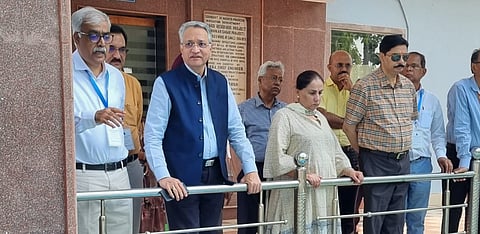

The tribunal, constituted by the Union government on March 12, 2018 under the Inter-State River Water Disputes Act, 1956, is led by Justice A.M. Khanwilkar, and comprises two retired high court judges.
—
RECENTLY, the Mahanadi Water Disputes Tribunal completed an extensive nine-day tour of the Mahanadi basin area in Chhattisgarh, during which it inspected a network of dams, barrages and tanks, apart from meeting farmers.
The Union government constituted the tribunal as an alter ego to the jurisdiction of the Supreme Court under Article 131 (original jurisdiction of the Supreme Court) of the Constitution, on March 12, 2018, under Section 4(1) of the Inter-State River Water Disputes Act, 1956 read with Article 262(1) (adjudication of disputes relating to waters of inter-state rivers or river valleys) of the Constitution. This tribunal comprises three then sitting judges nominated by the Chief Justice of India: Justice Ajay M. Khanwilkar as chairperson (who subsequently retired as a judge at the Supreme Court), and Justice Dr Ravi Ranjan (who subsequently retired as the Chief Justice of the Jharkhand High Court) and Justice Inderjeet Kaur Kochhar (who subsequently retired as a judge at the Delhi High Court) as members.
Additionally, former member of the Central Water Commission Sanjiv Aggarwal and Professor of Hydrology Dr Vijay Kumar Dwivedi have been serving as assessors in the tribunal since June 11, 2019.
The tribunal has been tasked with the adjudication of high-stake water disputes emerging from complaints filed by the states of Odisha and Chhattisgarh under Section 3 (complaints by state governments as to water disputes) of the Act.
The crux of the water dispute, as per Odisha's complaint, is that in 1947, when the Hirakud Dam was planned, the then Central Province and Odisha had agreed, under the mediation of Dr B.R. Ambedkar, to share 20.61 million acre-feet (MAF) of the Mahanadi in the proportion of 12.28 MAF for Odisha and 8.33 MAF for the Central Province— the predecessor of Chhattisgarh.
However, Odisha says Chhattisgarh has planned for the utilisation of 27.26 MAF, as disclosed in a letter in 2017. Odisha has also complained that, of the 12.28 MAF, it is entitled to receive 2 MAF in non-monsoon months from November to May, but after 2008, it has been receiving much less, causing serious detriment to its power, irrigation and environmental needs.
However, Chhattisgarh has contested each of the claims by Odisha. It has denied that there was any understanding in 1947.
On April 18 this year, the tribunal began its first tranche of visits. These were followed by a second tranche, starting April 29, which concluded at Raigarh on May 3, near the inter-state border. During this time, the tribunal visited sensitive areas and major reservoirs such as the Ravishankar reservoir, the Murumsilli dam and the Minimata dam. The tribunal also visited some tanks and barrages in interior areas.
The tribunal also visited six industrial barrages, including Rajiv Samoda, Basantpur and Kalma, on the main Mahanadi river. These are directly responsible for causing immediate problems during non-monsoons, Odisha alleges. They are constructed, according to Odisha, in a manner so as to create a column of storage in the river for 84 km, as the full reservoir level of the downstream barrage is the level of a foot of upstream barrage.
Chhattisgarh has disputed this claim of Odisha.
At the conclusion of the visit, Odisha alleged that Chhattisgarh was found storing excessive water at the end of the season, and that this wrongfully stored water has been responsible for shortages at the interstate border and the downstream Hirakud dam during non-monsoon months. However, Chhattisgarh explained that the storage was meant for Nishtari (daily summer) uses, among other things.
The tribunal was accompanied by several high-profile lawyers and well-known technical experts. Senior advocates Amal Ganguly and Mohan Katarki led the Chhattisgarh and Odisha teams, respectively.
The intensive inspection was cordial, with the exception of some angry exchanges on data. Odisha alleged that the live storage of the Minimata dam in Chhattisgarh is about two-thirds of Hirakud. On the other hand, Chhattisgarh tried to show that if gross storage is considered, that of Minimata is much less.
The second phase of visit in Odisha's territory will begin on May 19, and go till May 28, covering ecological hot spots like the Chilika lake in the Mahanadi delta, and the Hirakud reservoir, an engineering marvel that is the longest earthen dam in the world, running 26 km.